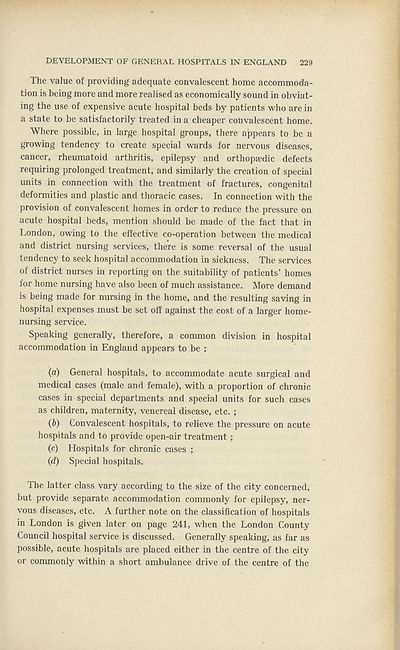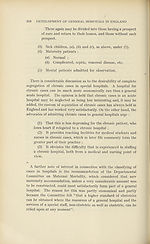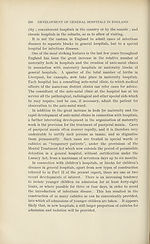Download files
Complete book:
Individual page:
Thumbnail gallery: Grid view | List view

DEVELOPMENT OF GENERAL HOSPITALS IN ENGLAND 229
The value of providing adequate convalescent home accommoda¬
tion is being more and more realised as economically sound in obviat¬
ing the use of expensive acute hospital beds by patients who are in
a state to be satisfactorily treated in a cheaper convalescent home.
Where possible, in large hospital groups, there appears to be a
growing tendency to create special wards for nervous diseases,
cancer, rheumatoid arthritis, epilepsy and orthopaedic defects
requiring prolonged treatment, and similarly the creation of special
units in connection with the treatment of fractures, congenital
deformities and plastic and thoracic cases. In connection with the
provision of convalescent homes in order to reduce the pressure on
acute hospital beds, mention should be made of the fact that in
London, owing to the effective co-operation between the medical
and district nursing services, there is some reversal of the usual
tendency to seek hospital accommodation in sickness. The services
of district nurses in reporting on the suitability of patients’ homes
for home nursing have also been of much assistance. More demand
is being made for nursing in the home, and the resulting saving in
hospital expenses must be set off against the cost of a larger home¬
nursing service.
Speaking generally, therefore, a common division in hospital
accommodation in England appears to be :
(a) General hospitals, to accommodate acute surgical and
medical cases (male and female), with a proportion of chronic
cases in special departments and special units for such cases
as children, maternity, venereal disease, etc. ;
(b) Convalescent hospitals, to relieve the pressure on acute
hospitals and to provide open-air treatment ;
(c) Hospitals for chronic cases ;
(d) Special hospitals.
The latter class vary according to the size of the city concerned,
but provide separate accommodation commonly for epilepsy, ner¬
vous diseases, etc. A further note on the classification of hospitals
in London is given later on page 241, when the London County
Council hospital service is discussed. Generally speaking, as far as
possible, acute hospitals are placed either in the centre of the city
or commonly within a short ambulance drive of the centre of the
The value of providing adequate convalescent home accommoda¬
tion is being more and more realised as economically sound in obviat¬
ing the use of expensive acute hospital beds by patients who are in
a state to be satisfactorily treated in a cheaper convalescent home.
Where possible, in large hospital groups, there appears to be a
growing tendency to create special wards for nervous diseases,
cancer, rheumatoid arthritis, epilepsy and orthopaedic defects
requiring prolonged treatment, and similarly the creation of special
units in connection with the treatment of fractures, congenital
deformities and plastic and thoracic cases. In connection with the
provision of convalescent homes in order to reduce the pressure on
acute hospital beds, mention should be made of the fact that in
London, owing to the effective co-operation between the medical
and district nursing services, there is some reversal of the usual
tendency to seek hospital accommodation in sickness. The services
of district nurses in reporting on the suitability of patients’ homes
for home nursing have also been of much assistance. More demand
is being made for nursing in the home, and the resulting saving in
hospital expenses must be set off against the cost of a larger home¬
nursing service.
Speaking generally, therefore, a common division in hospital
accommodation in England appears to be :
(a) General hospitals, to accommodate acute surgical and
medical cases (male and female), with a proportion of chronic
cases in special departments and special units for such cases
as children, maternity, venereal disease, etc. ;
(b) Convalescent hospitals, to relieve the pressure on acute
hospitals and to provide open-air treatment ;
(c) Hospitals for chronic cases ;
(d) Special hospitals.
The latter class vary according to the size of the city concerned,
but provide separate accommodation commonly for epilepsy, ner¬
vous diseases, etc. A further note on the classification of hospitals
in London is given later on page 241, when the London County
Council hospital service is discussed. Generally speaking, as far as
possible, acute hospitals are placed either in the centre of the city
or commonly within a short ambulance drive of the centre of the
Set display mode to:
![]() Universal Viewer |
Universal Viewer | ![]() Mirador |
Large image | Transcription
Mirador |
Large image | Transcription
Images and transcriptions on this page, including medium image downloads, may be used under the Creative Commons Attribution 4.0 International Licence unless otherwise stated. ![]()
| League of Nations > Health > Quarterly bulletin of the Health Organisation > Volume 3 > (237) |
|---|
| Permanent URL | https://digital.nls.uk/191560045 |
|---|
| Attribution and copyright: |
|
|---|---|
| Description | League of Nations |
|---|---|
| Shelfmark | LN.III.12.(1) |
| Shelfmark | LN.III |
|---|---|
| Description | Over 1,200 documents from the non-political organs of the League of Nations that dealt with health, disarmament, economic and financial matters for the duration of the League (1919-1945). Also online are statistical bulletins, essential facts, and an overview of the League by the first Secretary General, Sir Eric Drummond. These items are part of the Official Publications collection at the National Library of Scotland. |
|---|---|
| Additional NLS resources: |
|

